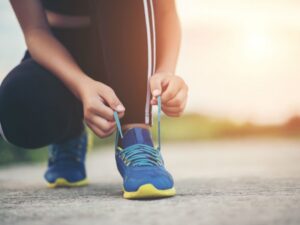
Introduction to Running Medicine
We all know that running is very healthy for you, but we also know that it carries its own risks as running injuries are very common. Studies show anywhere from 30-80 percent of runners are injured during a given year, leading to missing some runs.
Thankfully, I don’t deal with life and death situations in my clinic, but the equivalent in Running Medicine is telling a runner he or she needs to take time off. I’ve had patients try begging, bargaining, threatening, and crying to get permission to run, sometimes all in the same visit! My mentor, Dr. Robert Wilder, looked at these injuries as initiation into the club, telling patients, “You have runner’s knee. Congratulations, you know you’re a runner now!” And the great Philosopher of Running, Dr. George Sheehan, called these running related injuries “Diseases of Excellence.” Although some look at injuries as a badge of honor, most of you probably don’t need this type of validation.
We can’t stop all running injuries, but we can take steps to lower our risk. There are three main categories contributing to our running, and significant problems in any of these can lead to an injury. Here is graphical representation borrowed from Dr. Irene Davis:

Your injury risk is a combination of structure, mechanics, and dosage. Let’s briefly discuss each one for now, and then go into more detail in future posts.
Structure is your anatomy and possibly any orthopedic injuries you’ve had. It mostly comes from the genetic hand you were dealt, and you can either blame or thank your parents for it. These are things that we can’t easily change like your knee alignment, bunions, or retroverted hips which make your feet turn out when you walk and run. (Side note: not everyone’s feet should point straight ahead, and not every turned out foot means over-pronation!)
Some structural issues can be improved with surgery, like ACL repair or bunionectomy. Some can be modified with orthotics and shoes, like using toe spreader devices with wide toe boxed shoes for bunions.
Biomechanics is definitely related to structure, but tends to be things that we can more easily modify. While not everyone should move the exact same way, there are definite commonalities of great runners and also of injured runners. A specific amount of mobility, stability, and strength is needed to run well. Biomechanics is the part of the injury equation where I spend most of my time to have the biggest effect. The best part of my job is that improving mechanics can not only fix injuries, but also improve efficiency. Increased efficiency leads to decreased race times!
Dosage is your training. Exercise is medicine and can be prescribed like a drug–certain types in certain dosages and frequencies. Many folks follow online plans like Couch to 5K or Runner’s World guides. Some run with local clubs or pay for personal coaching. This category is probably the single biggest factor for determining your injury risk. Sudden changes in training are a huge risk for runners. This is the classic ‘Too much, too fast, too soon’ mistake. If you have really been a true couch potato for several years, going from zero running to 2.5 miles in a few weeks is not a great idea. Even experienced runners can make silly mistakes in this category.
Finally, we have the evil red line of the injury threshold. Like structure, there is likely a genetic component to where this line sits for each of us. This is why some runners can follow a smart training plan and work on mechanics and still get injured frequently, while others seem to do everything “wrong,” but train and race weekly without injury. Unfortunately, many of us cross the injury line several times before we start figuring out where our line sits.
Now you should have a better understanding of the global picture of running injuries. If you have poor structure, bad mechanics, and don’t train smartly, you’ll have a tough time staying on the roads. If you were born with great structure, have wonderful mechanics, and train smartly, then I’ll see you at the finish line. This was heavy in philosophy, but I want you to think about your training in a holistic way. If you are unfortunate enough to be in that 30–80 percent injury statistic, please find a doctor or therapist who doesn’t just look at the injured body part without asking about your training or assessing overall mechanics. Of course, I would be happy to see you as well.
Happy Running!

Dr. Kasey Hill is a Physical Medicine and Rehabilitation physician, or Physiatrist. He received his undergraduate degree at Louisiana State University and in 2007 he earned his medical degree at LSU School of Medicine in New Orleans. He is board certified by the American Board of Physical Medicine & Rehabilitation. During residency at the University of Virginia, he received specialized training in treating running injuries by working with Dr. Robert Wilder, director of The Runner's Clinic, and Jay Dicharry, PT, gait analysis expert and author of Anatomy for Runners.
Dr. Hill has been on staff at Ochsner since 2019 and practicing medicine since 2011. His expertise is in conservative treatment of musculoskeletal injuries, EMG & nerve testing, sports medicine, running medicine, and concussion management. He believes in using an interdisciplinary team approach for patient care: coordinating care with other physicians, parents, coaches, trainers, and therapists for sports injuries. His goal is to keep his patients as active as possible while treating the root cause of their injuries.





